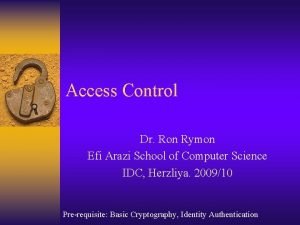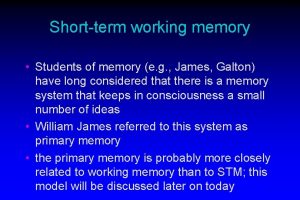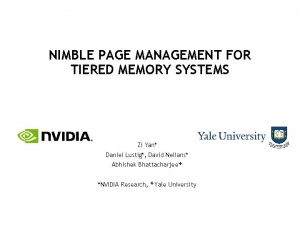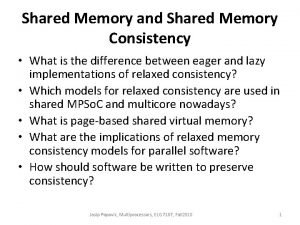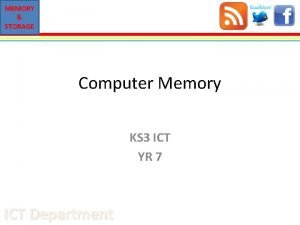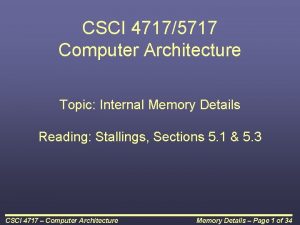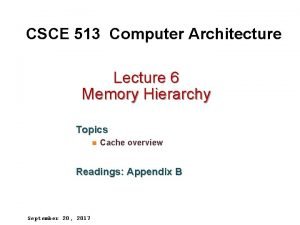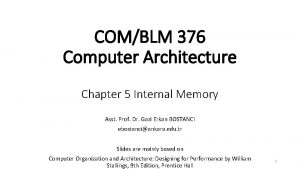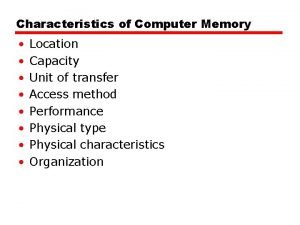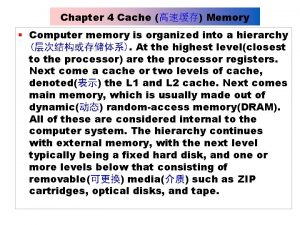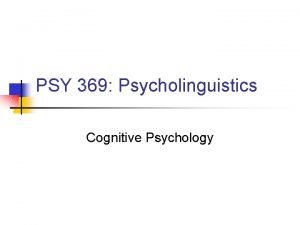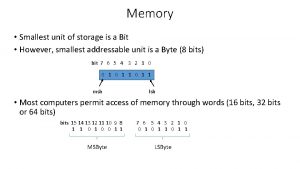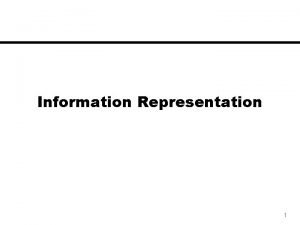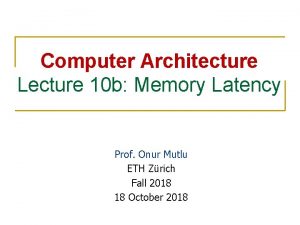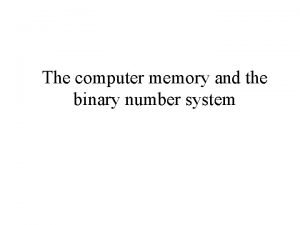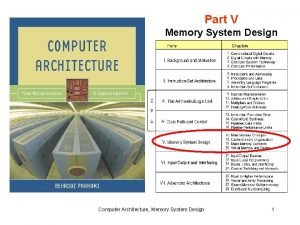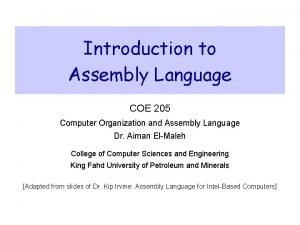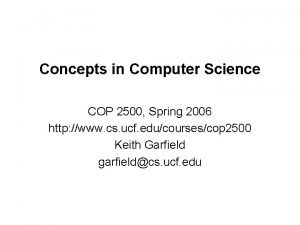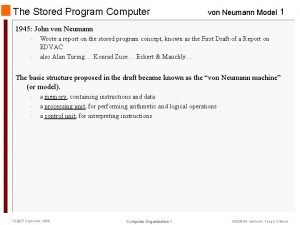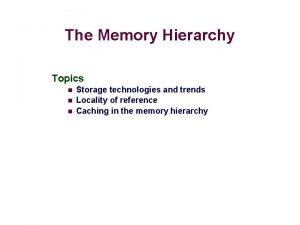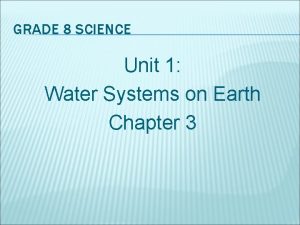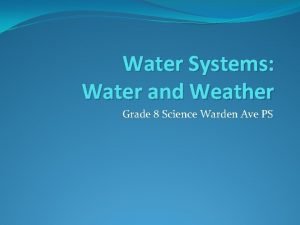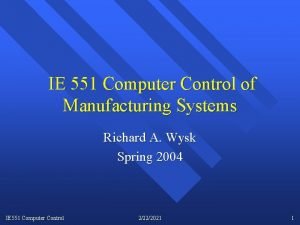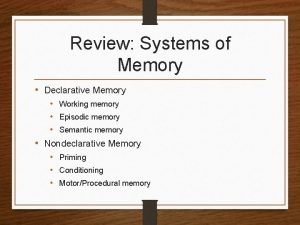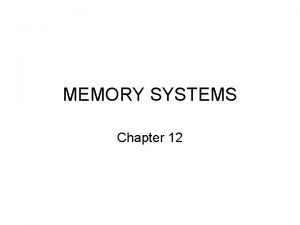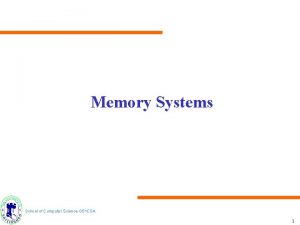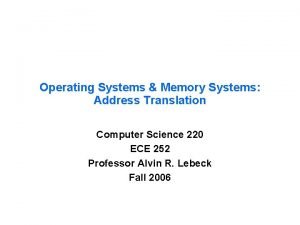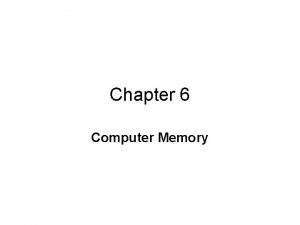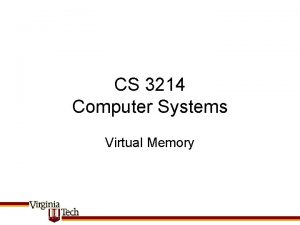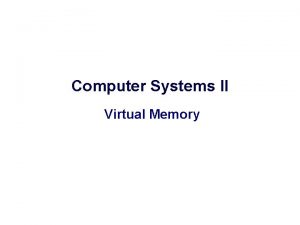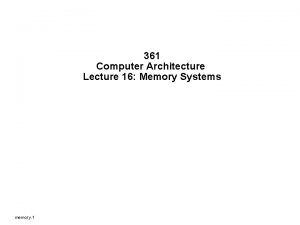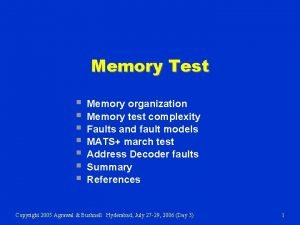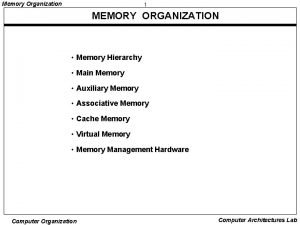Memory Systems School of Computer Science G 51



























































- Slides: 59

Memory Systems School of Computer Science G 51 CSA 1

Computer Memory System Overview J Historically, the limiting factor in a computer’s performance has been memory access time J Memory speed has been slow compared to the speed of the processor J A process could be bottlenecked by the memory system’s inability to “keep up” with the processor School of Computer Science G 51 CSA 2

Computer Memory System Overview Terminology J Capacity: (For internal memory) Total number of words or bytes. (For external memory) Total number of bytes. J Word: the natural unit of organization in the memory, typically the number of bits used to represent a number - typically 8, 16, 32 J Addressable unit: the fundamental data element size that can be addressed in the memory -- typically either the word size or individual bytes J Access time: the time to address the unit and perform the transfer J Memory cycle time: Access time plus any other time required before a second access can be started School of Computer Science G 51 CSA 3

Memory Hierarchy J Major design objective of any memory system J To provide adequate storage capacity at J An acceptable level of performance J At a reasonable cost J Four interrelated ways to meet this goal J Use a hierarchy of storage devices J Develop automatic space allocation methods for efficient use of the memory J Through the use of virtual memory techniques, free the user from memory management tasks J Design the memory and its related interconnection structure so that the processor can operate at or near its maximum rate School of Computer Science G 51 CSA 4

Basis of the memory hierarchy J Registers internal to the CPU for temporary data storage (small in number but very fast) J External storage for data and programs (relatively large and fast) J External permanent storage (much larger and much slower) J Remote Secondary Storage (Distributed File Systems, Web Servers) School of Computer Science G 51 CSA 5

The Memory Hierarchy Smaller Faster Costlier (per byte) Level 0 Level 1 Level 2 Larger Slower Cheaper (per byte) Level 3 Level 4 Level 5 School of Computer Science G 51 CSA 6

Typical Memory Parameters School of Computer Science G 51 CSA 7

Typical Memory Parameters Suppose that the processor has access to two levels of memory. Level 1 contains 1000 words and has an access time of 0. 01 ms; level 2 contains 100, 000 words and has an access time of 0. 1 ms. Assuming that if a word to be accessed is in level 1, then the processor access it directly. If it is in level 2, then the word is first transferred to level 1 and then accessed by the processor. For simplicity, ignore the time required for the processor to determined whether is in level 1 or level 2. A typical performance of a simple two level memory has this shape: School of Computer Science G 51 CSA 8

Typical Memory Parameters T 1 = access time for level 1 T 2 = access time for level 2 Suppose 95% of the memory accesses are found in level 1 the average time to access a word is (0. 95)(0. 01 ms) + (0. 005)(0. 01 ms + 0. 1 ms) = H - fraction of all memory accesses that are found in the faster memory 0. 015 ms School of Computer Science G 51 CSA 9

The Locality Principle The memory hierarchy works because of locality of reference J Well written computer programs tend to exhibit good locality. That is, they tend to reference data items that are near other recently referenced data items, or that were recently referenced themselves. This tendency is known as the locality principle. J All levels of modern computer systems, from the hardware, to the operating system, to the application programs, are designed to exploit locality. School of Computer Science G 51 CSA 10

The Locality Principle J At hardware level, the principle of locality allows computer designers to speed up main memory accesses by introducing small fast memories known as the cache memories. J At operating system level, main memory is used to cache the most recently referenced chunks of virtual address space and the most recently used disk blocks in a disk file system. J At application level, Web browsers cache recently referenced documents in local disk School of Computer Science G 51 CSA 11

Cache Memory m Small amount of fast memory m Sits between normal main memory and CPU m May be located on CPU chip or module m Intended to achieve high speed at low cost School of Computer Science G 51 CSA 12

Cache Memory J Cache retains copies of recently used information from main memory, it operates transparently from the programmer, automatically decides which values to keep and which to overwrite. J An access to an item which is in the cache: hit J An access to an item which is not in the cache: miss J The proportion of all memory accesses that are found in cache: hit rate School of Computer Science G 51 CSA 13

Cache operation - overview m CPU requests contents of memory location m Check cache for this data m If present, get from cache (fast) m If not present, read required block from main memory to cache m Then deliver from cache to CPU School of Computer Science G 51 CSA 14

Typical Cache Organization School of Computer Science G 51 CSA 15

Cache/Main Memory Structure m. Main memory consists of fixed length blocks of K words (M = 2 n/K blocks) m. Cache consists of C Lines of K words each m. The number of lines is much less than the number of blocks (C << M) m. Block size = Line Size Cache includes tags to identify which block of main memory is in each cache slot School of Computer Science G 51 CSA 16

Mapping Function m. Fewer cache line than main memory block m. Need to determine which memory block currently occupies a cache line m. Need an algorithm to map memory block to cache line m. Three Mapping Techniques: m. Direct m. Associative m. Set associative School of Computer Science G 51 CSA 17

Direct Mapping m. Each main memory address can be viewed as consisting 3 fields: 2 The least significant w bits identify a unique word or byte within a block of main memory 2 The remaining s bits specify one of 2 s blocks of main memory 2 The cache logic interprets these s bits as: 2 a tag field of s - r bits (most significant portion) 2 a line field of r bits s-r r w Cache line Main Memory blocks held 0 0, m, 2 m, 3 m… 2 s-m 1 1, m+1, 2 m+1… 2 s -m+1 … … m-1, 2 m-1, 3 m-1… 2 s -1 m=2 r line of cache School of Computer Science G 51 CSA 18

Direct Mapping School of Computer Science G 51 CSA 19

CPU t l Direct Mapping t (t+l+w) Address Bus t w w l l w 2(l+w) Words 2 w Words 2 t 2 w Words 2 l Cache line 2 l Blocks Cache Main Memory School of Computer Science G 51 CSA 20

Direct Mapping Example System: Cache of 64 k. Byte Cache block of 4 bytes - i. e. cache is 16 k (214) lines of 4 bytes 16 MBytes main memory - 24 bit address (224=16 M) Cache line Starting memory address of block 0 000000, 010000, …, FF 0000 1 000004, 010004, …, FF 00004 … … m-1 00 FFFC, 01 FFFC, …, FFFFC School of Computer Science G 51 CSA 21

CPU Direct Mapping 24 8 14 2 Address Bus A 16~ A 2~A 15 A 0~A 1 A 23 A 16~A 23 A 2~A 15 A 0~A 1 2(l+w) Words 22 Words 28 214 Cache line Cache 22 Words 214 Blocks Main Memory School of Computer Science G 51 CSA 22

Direct Mapping Memory Address Cache Tag Line Word FFF 9 CA 81 FCAE School of Computer Science G 51 CSA 23

Direct Mapping Example: Memory size 1 MB (20 address bits) addressable to individual bytes Cache size of 1 K lines, each 8 bytes Word id = 3 bits Line id = 10 bits Tag id = 7 bits Where is the byte stored at main memory location ABCDE stored in the cache Cache Line # Word location Tag id School of Computer Science G 51 CSA 24

Direct Mapping • Simple • Inexpensive • Fixed location for given block • If a program accesses 2 blocks that map to the same line repeatedly, cache misses are very high School of Computer Science G 51 CSA 25

Associative Mapping m A main memory block can load into any line of cache m Memory address is interpreted as tag and word m Tag uniquely identifies block of memory m Every line’s tag is examined for a match m Cache searching gets expensive School of Computer Science G 51 CSA 26

Associative Mapping School of Computer Science G 51 CSA 27

CPU t Associative Mapping (t+w) w t w Address Bus t w 2 w Words 2 l Cache line Cache 2 t Blocks Main Memory School of Computer Science G 51 CSA 28

Associative Mapping Example System: Cache of 64 k. Byte Cache block of 4 bytes i. e. cache is 16 k (214) lines of 4 bytes 16 MBytes main memory 24 bit address (224=16 M) School of Computer Science G 51 CSA 29

CPU 22 Associative Mapping 24 2 22 2 Address Bus A 2~A 24 A 0~A 1 2 w Words 22 Words 2 l Cache line Cache 222 Blocks Main Memory School of Computer Science G 51 CSA 30

Associative Mapping Memory Address Cache Tag Word FFF 9 CA 81 FCAE School of Computer Science G 51 CSA 31

Associative Mapping Example: Memory size 1 MB (20 address bits) addressable to individual bytes Cache size of 1 K lines, each 8 bytes Word id = 3 bits Tag id = 17 bits Where is the byte stored at main memory location ABCDE stored in the cache Word location Tag id School of Computer Science G 51 CSA 32

Set Associative Mapping o. Cache is divided into a number of sets o. Each set contains a number of lines o. A given block maps to any line in a given set Address length = (s + w) bits Number of addressable units = 2 s+w bytes or words Block size = line size = 2 w bytes or words Number of blocks in main memory = (2 s+w)/2 w = 2 s Number of lines in set = k Number of sets v = 2 d Number of lines in cache = kv = k x 2 d Size of tag = (s - d) bits School of Computer Science G 51 CSA 33

Set Associative Mapping School of Computer Science G 51 CSA 34

CPU t s Set 0 Set Associative Mapping (t+s+w) w t w s Address Bus (t+s) w 2 w Words Set 2 s-1 2 s Set k lines/set Cache 2(t+s) Blocks Main Memory School of Computer Science G 51 CSA 35

Set Associative Mapping Cache of 64 k. Byte Cache block of 4 bytes - i. e. cache is 16 k (214) lines of 4 bytes 16 MBytes main memory - 24 bit address (224=16 M) 2 lines in each set 16 k/2 = 8 k set School of Computer Science G 51 CSA 36

CPU 9 13 Set 0 Set Associative Mapping 24 9 13 Address Bus A 2~A 23 2 2 A 0~A 1 2 w Words Set 2 s-1 213 Sets 2 lines/set Cache 222 Blocks Main Memory School of Computer Science G 51 CSA 37

Set Associative Mapping Use set field to determine cache set to look in Compare tag field to see if we have a hit, e. g Memory Address Cache Tag Set number word FFF 9 CA 81 FCAE School of Computer Science G 51 CSA 38

Set Associative Mapping Example: Memory size 1 MB (20 address bits) addressable to individual bytes Cache size of 1 K lines, each 8 bytes 4 -way set associative mapping Word id = 3 bits 1024/4 = 256 sets Set id = 8 bit Tag id = 17 bits Where is the byte stored at main memory location ABCDE stored in the cache Word location Set Tag School of Computer Science G 51 CSA 39

Replacement Algorithms p. When a new block is brought into the cache, one of the existing blocks must be replaced. p. Direct Mapping: One possible line for any particular block - No choice p. Associative/Set Associative Mapping: p. Least Recently used (LRU): Replace block that has not been referenced the longest. E. g. in 2 way set associative, Which of the 2 block is LRU? p. First in first out (FIFO): replace block that has been in cache longest p. Least frequently used: replace block which has had fewest hits p. Random School of Computer Science G 51 CSA 40

Write Policy J Before a block that is resident in the cache can be replaced, it is necessary to consider whether it has been altered in the cache but not in the main memory. J If it has not (been altered in cache), then the old block in the cache can be overwritten. J If it has (been altered in cache), it means at least one write operation has been performed on a word in that cache line and main memory must be updated accordingly. School of Computer Science G 51 CSA 41

Write Policy Write Through: All writes go to main memory as well as cache Multiple CPUs can monitor main memory traffic to keep local (to CPU) cache up to date Lots of traffic Slows down writes Write Back Updates initially made in cache only Update bit for cache slot is set when update occurs If block is to be replaced, write to main memory only if update bit is set Other caches get out of sync I/O must access main memory through cache N. B. 15% of memory references are writes School of Computer Science G 51 CSA 42

Line Size Larger blocks reduce the number of blocks that fit into the cache. As block becomes larger, each additional word is farther from the requested word, therefore less likely to be needed in the near future School of Computer Science G 51 CSA 43

Pentium 4 Cache School of Computer Science G 51 CSA 44

Power. PC Cache School of Computer Science G 51 CSA 45

External Memory School of Computer Science G 51 CSA 46

Memory Hierarchy School of Computer Science G 51 CSA 47

Magnetic Disks School of Computer Science G 51 CSA 48

Magnetic Disks J Each sector on a single track contains one block of data, typically 512 bytes, and represents the smallest unit that can be independently read or written. J Regardless of the track, the same angle is swept out when a sector is accessed, thus the transfer time is kept constant when the motor rotating at a fixed speed. This technique is known as CAV Constant Angular Velocity. School of Computer Science G 51 CSA 49

Magnetic Disks Seek time: the time required to move from one track to another Latency time: After the head is on the desired track, the time taken to locate to correct sector. Transfer time: Time taken to transfer one block of data. School of Computer Science G 51 CSA 50

Magnetic Disks After the head is on the desired track, the time taken to locate to correct sector Maximum Latency Time Average Latency Time taken to transfer one block of data Transfer Time School of Computer Science G 51 CSA 51

Magnetic Disks A single data block Header for MS-DOS/Windows disk School of Computer Science G 51 CSA 52

Magnetic Disks Disk interleaving School of Computer Science G 51 CSA 53

Magnetic Disks A floppy disk is rotating at 300 rpm (revolutions per minute). The disk is divided in to 12 sectors, with 40 tracks on the disk. The disk is singled sided. A block consists of a single sector on a single track. Each block contains 200 bytes. What is the disk capacity in bytes? What is the maximum and minimum latency time for this disk? What is the transfer time for a single block? School of Computer Science G 51 CSA 54

Magnetic Disks A multiplattered hard disk is divided into 40 sectors and 400 cylinders. There are four platter surfaces. The total capacity of the disk is 128 MB. A cluster consists of 4 blocks. The disk is rotating at a rate of 4800 rpm. The disk has an average seek time of 12 msec. What is the capacity of a cluster for this disk? What is the disk transfer rate in bytes per second? What is the average latency time for the disk? School of Computer Science G 51 CSA 55

Optical Disks School of Computer Science G 51 CSA 56

Optical Disks J CD format designed for maximum capacity J Each block the same length along the track, regardless of locations J More bits per revolution at the outside of the disk than at the inside J A variable speed motor is used to keep transfer rate constant J The disk move slower when the outside tracks are be read J Constant Linear Velocity, CLV School of Computer Science G 51 CSA 57

Optical Disks School of Computer Science G 51 CSA 58

Others J Tape J RAID J. . . School of Computer Science G 51 CSA 59
 What is your favorite lesson
What is your favorite lesson Ron rymon
Ron rymon Erik jonsson school of engineering and computer science
Erik jonsson school of engineering and computer science Erik jonsson school of engineering and computer science
Erik jonsson school of engineering and computer science Erik jonsson school of engineering and computer science
Erik jonsson school of engineering and computer science Semantic knowledge
Semantic knowledge Implicit memory vs explicit memory
Implicit memory vs explicit memory Long term memory vs short term memory
Long term memory vs short term memory Internal memory and external memory
Internal memory and external memory Primary memory and secondary memory
Primary memory and secondary memory Logical versus physical address space
Logical versus physical address space Which memory is the actual working memory?
Which memory is the actual working memory? Virtual memory
Virtual memory Virtual memory in memory hierarchy consists of
Virtual memory in memory hierarchy consists of Eidetic memory vs iconic memory
Eidetic memory vs iconic memory Shared vs distributed memory
Shared vs distributed memory Slave systems working memory model
Slave systems working memory model Nimble page management for tiered memory systems
Nimble page management for tiered memory systems Memory consistency
Memory consistency Memory system
Memory system Two types of computer memory
Two types of computer memory Explain virtual memory in computer architecture
Explain virtual memory in computer architecture Computer architecture
Computer architecture Advanced dram organization
Advanced dram organization Memory hierarchy
Memory hierarchy Short term memory computer
Short term memory computer Presentation on computer memory
Presentation on computer memory Memory organisation in computer architecture
Memory organisation in computer architecture Computer memory hierarchy diagram
Computer memory hierarchy diagram Internal memory in computer architecture
Internal memory in computer architecture Computer memory system overview
Computer memory system overview Characteristics of computer memory
Characteristics of computer memory Computer memory system overview
Computer memory system overview Computer analogy
Computer analogy Smallest memory unit
Smallest memory unit Data representation in computer architecture
Data representation in computer architecture Memory latency in computer architecture
Memory latency in computer architecture What is computer memory
What is computer memory Memory in computer
Memory in computer Symbol table in assembler
Symbol table in assembler What is computer memory
What is computer memory Emerging memory technologies
Emerging memory technologies Modello von neumann
Modello von neumann Storage hierarchy
Storage hierarchy Decision support systems and intelligent systems
Decision support systems and intelligent systems Principles of complex systems for systems engineering
Principles of complex systems for systems engineering Embedded systems vs cyber physical systems
Embedded systems vs cyber physical systems Elegant systems
Elegant systems Water systems grade 8
Water systems grade 8 Grade 8 science water systems
Grade 8 science water systems Natural vs social science
Natural vs social science What are the main branches of natural science
What are the main branches of natural science Natural science vs physical science
Natural science vs physical science Applied science vs pure science
Applied science vs pure science Anthropology vs sociology
Anthropology vs sociology Extra credit
Extra credit Rule of 70 population growth
Rule of 70 population growth Windcube
Windcube Soft science definition
Soft science definition Computer control of manufacturing systems
Computer control of manufacturing systems

